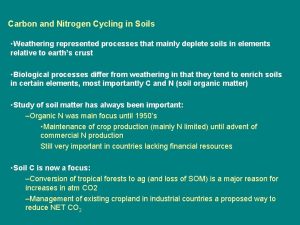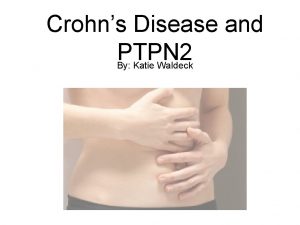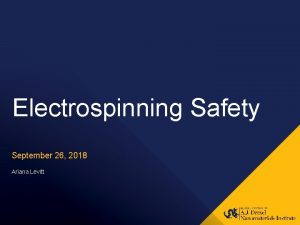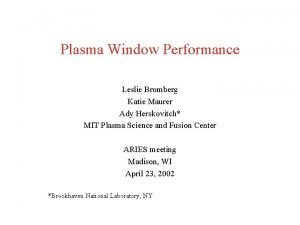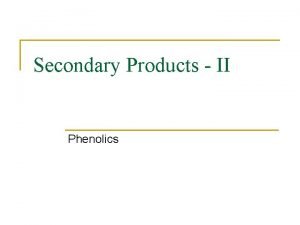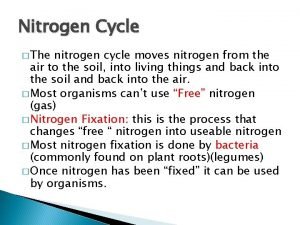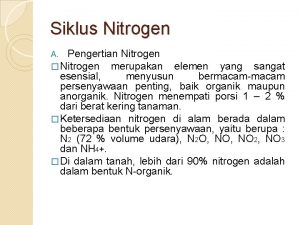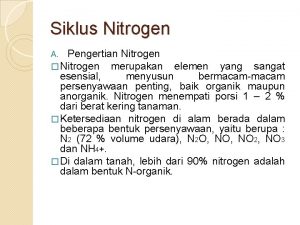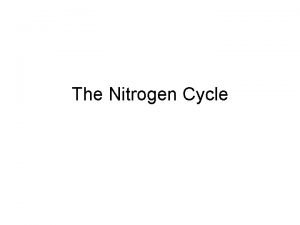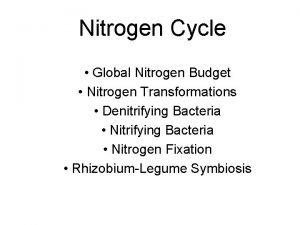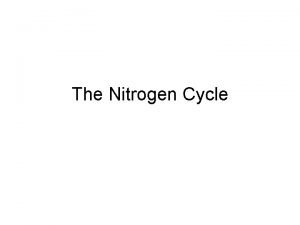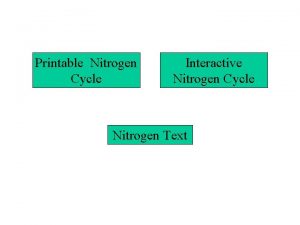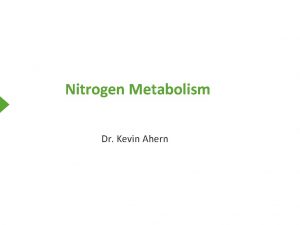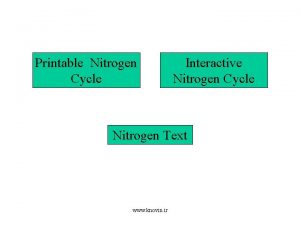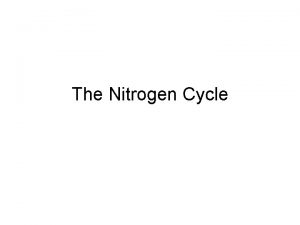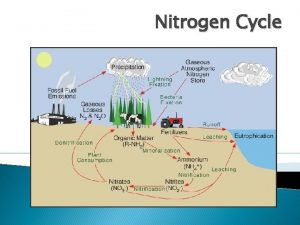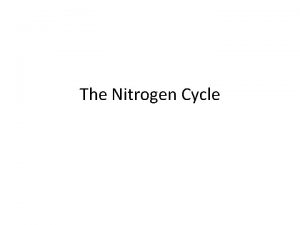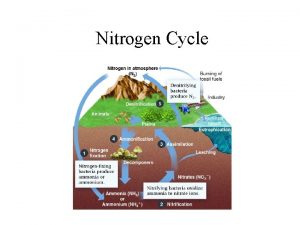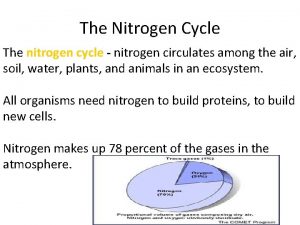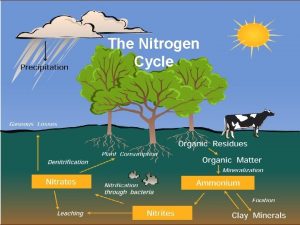USING PHENOLICS TO INCREASE SOIL NITROGEN RETENTION Katie

























- Slides: 25

USING PHENOLICS TO INCREASE SOIL NITROGEN RETENTION Katie Slebodnik Jennifer Reeve, Ph. D. Jeanette Norton, Ph. D. Jennifer Mac. Adam, Ph. D. Karen Beauchemin, Ph. D.

CONTENTS 1. Introduction 2. Incubation Experiment Methods Results Discussion 3. Conclusion

THE PROBLEM: • Increasing demand for pasture-finished beef

http: //www. uppermissouriwaterkeeper. org/talking-points-public-comment-on-the-draft-cafo-general-

http: //www. thesleuthjournal. com/why-eat-grass-fed-beef/

THE PROBLEM: • Increasing demand for pasture-finished beef • Feedlots pose environmental challenges • But… so do pastures

PASTURES • Pastures subject to nitrogen (N) leaching and nitrous oxide (N 2 O) production • 16 -33% agricultural N 2 O emissions From de Klien, Pinares-Patino, and Waghorn (2008) Figure

THE REALITY: Grass fed beef requires more cows, grazing for a longer period of time to produce the equivalent amount of feedlot-finished beef.

FOR 1, 000 KG OF BEEF: Feedlot: Pasture: emissions per kg beef emissions per area of land

WHICH IS BETTER? • Complex problem • Hope for pasture-finished beef • Ecosystem services • Soil is a regulator From Baveye et al 2016

PHENOLICS • Secondary plant compounds • Tannins increase N retention in forest systems • In soil: • Sorb to soil OM • Bind proteins • Microbial toxicity • In cow: • Decrease NH 3 production https: //www. researchgate. net/figure/Chemical-structure-of-a-hydrolysa tannin-HT-and-b-condensed-tannin-CT-when-R_fig 8_265556106

PHENOLICS https: //www. elkmoundseed. com • Tannins: • Birdsfoot trefoil and sainfoin • Saponins: • Alfalfa https: //www. mountvernon. org

OUR PROJECT Questions: • How do tannins affect soil N cycling processes? • How does these changes affect overall GHG intensity of pasture-finished beef? Objectives: 1. Field study 2. Manure/soil/tannin incubation 3. Soil/phenolic incubation 4. Whole-farm GHG modeling

INCUBATION EXPERIMENT Question: How does forage phenolic type and concentration affect various N cycling processes in a controlled environment? Hypothesis: Phenolics will immobilize N via sorption and complexation, protecting N from microbial activity

METHODS • 84 day soil/phenolics incubation • Treatments: • Birdsfoot trefoil (BFT) tannin (Low/High dose) • Sainfoin (SFN) tannin (Low/High dose) • Alfalfa (ALF) saponin (Low dose) • Control soil • Uniform pasture soil • 3 replicates/time point

METHODS • Measured: • Soil ammonium (NH 4+) and nitrate (NO 3 -) • Carbon dioxide (CO 2) and nitrous oxide (N 2 O) production • Ammonia (NH 3) volatilization • Autoclaved citrate extractable protein (Days 0 & 84) • Soluble C & N (Days 0 & 84) • Total phenolics in solution (Days 0 & 84) • Modeled after Halvorson et al 2009

RESULTS Hypothesis: Increasing doses of phenolics will create corresponding decrease in total C extracted. Day 84 Total C Extracted Day 0 Total C Extracted 2500 450 400 2000 Total C (mg C/L) 350 300 250 200 150 100 1500 1000 50 0 0 1 2 3 4 1 2 3 Number of Washes BFT High BFT Low Control SAP Low SFN High SFN Low 4

RESULTS Hypothesis: Increasing doses of phenolics will create corresponding decrease in total N extracted. Day 84 Total N Extracted 20 18 16 14 12 10 8 6 4 2 0 250 200 Total N (mg N/L) Day 0 Total N Extracted 150 100 50 0 1 2 3 4 1 Number of Washes 2 3 Number of Washes BFT High BFT Low Control SAP Low SFN High SFN Low 4

RESULTS Hypothesis: Control, low phenolic, and high phenolic treatments will have decreasing ACE protein, respectively. Autoclave Citrate Extractable Protein (mg/g ODE soil) ACE Protein 25 20 15 Day 0 10 Day 84 5 0 Control BFT Low SFN Low BFT High SFN High SAP Low Treatment

RESULTS Hypothesis: Control, low phenolic, and high phenolic treatments will have decreasing nitrate concentrations, respectively. Soil Nitrate Concentration (mg NO 3 --N/kg ODE soil) Average Soil Nitrate 45 40 35 30 25 20 15 10 5 0 -5 0 Control 2 7 14 28 39 56 70 Day of Incubation BFT Low SFN Low BFT High SFN High SAP Low 84

RESULTS Hypothesis: N 2 O production will increase from high phenolic treatments, low phenolic treatments, and the control, respectively. Cumulative N 2 O Production (µg N 2 O-N/kg soil) Cumulative N 2 O Production 45 40 35 30 BFT High 25 BFT Low 20 Control 15 SAP Low SFN High 10 SFN Low 5 0 0 10 20 30 40 50 60 Day of Incubation 70 80 90

RESULTS Hypothesis: CO 2 production will increase from the control, low phenolic treatments, then high phenolic treatments, respectively. Cumulative CO 2 Production (mg CO 2 -C/kg soil) 600 BFT High 500 BFT Low 400 Control SAP Low 300 SFN High 200 SFN Low 100 0 0 10 20 30 40 50 60 Day of Incubation 70 80 90

FUTURE WORK • Check for contamination • Analyze treatment C&N • Quantify total phenolics extracted • Analyze NH 3 volatilization • Continue researching tannin chemistry

PRELIMINARY CONCLUSIONS • Soluble C & N suggests phenolics are sorbing to soil OM • Nitrate & GHG data suggests significant microbial activity • Halvorson: sorption under abiotic conditions • Microbes may play a role under ambient conditions • Phenolics may increase N retention

ACKNOWLEDGEMENTS • Committee members: • Jennifer Reeve Ph. D • Jennifer Mac. Adam Ph. D • Jeanette Norton Ph. D • The Mac. Adam Lab • Karen South • Stephen Lee Ph. D • USDA-ARS Poisonous Plants Research Lab • WSARE Grant #GW 18 -156
 Sources of nitrogen
Sources of nitrogen Cosmetology
Cosmetology Water retention in soil
Water retention in soil Carbon and nitrogen cycling in soil:
Carbon and nitrogen cycling in soil: Living soil vs dead soil
Living soil vs dead soil Four major spheres of the earth
Four major spheres of the earth Katie waldeck
Katie waldeck Katie's trunk by ann turner
Katie's trunk by ann turner Katie truss
Katie truss Seno boards
Seno boards Katie levitt
Katie levitt Katie lippincott
Katie lippincott Katie fazio
Katie fazio Dr mustain uams
Dr mustain uams Katie bouman nobel prize
Katie bouman nobel prize Katie bell minneapolis
Katie bell minneapolis Katie mc grant
Katie mc grant Katie dallam story
Katie dallam story Katie schoultz
Katie schoultz Katie halvorson
Katie halvorson Katie maurer
Katie maurer Katie colpitts
Katie colpitts Katie be
Katie be Katie morag characters
Katie morag characters Nursing management of malabsorption syndrome
Nursing management of malabsorption syndrome Katie kraska
Katie kraska



